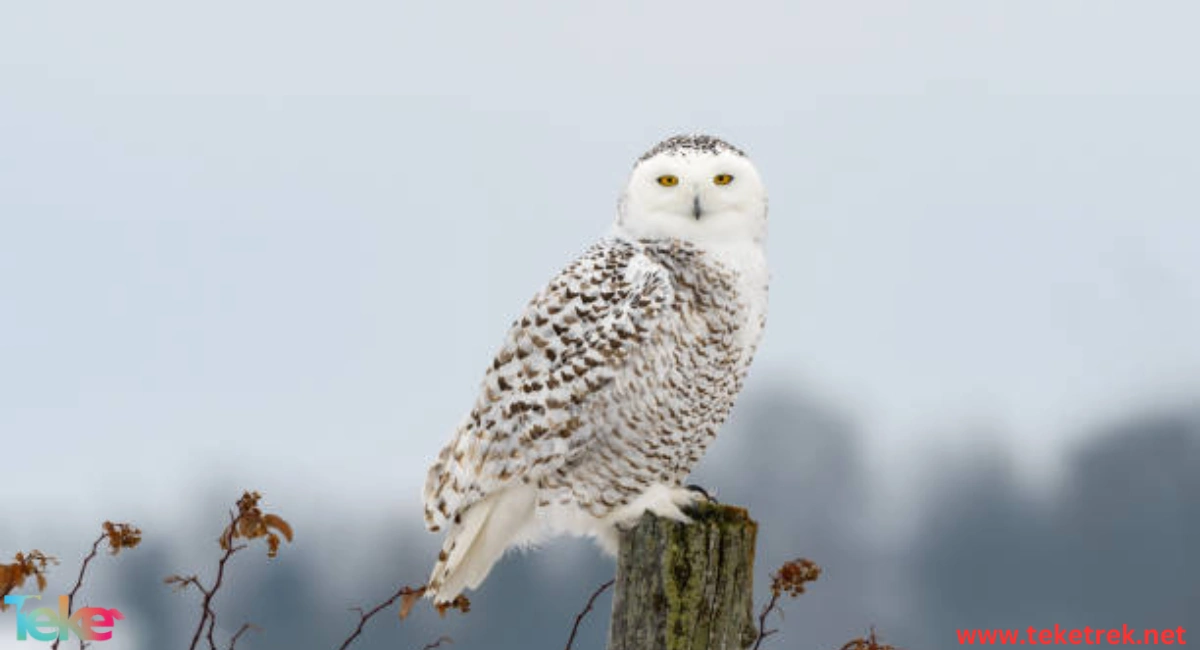is considered one of the most famous owls, known for its white feathers which provide excellent camouflage in snowy environments.
Let’s learn more about it from teketrek.
Facts about The Snowy Owl
The Snowy Owl is a very powerful owl, although not naturally clear.
It is believed to be closely related to the eagle owl.
Belonging to the owl family, phylum Chordata the Snowy Owl is characterized by the male’s black color, while the female has a reddish-brown color with tufted tops.
Although Snowy Owls prefer to be awake at dusk, they also hunt during the day and night depending on the main activity times of their prey.
Snowy Owls can withstand harsh weather conditions and have a great ability to adapt to all difficult circumstances.
Snowy Owls often sit motionless on rocks or hills for hours searching for prey.
This is possible because their entire body, including their feet, is covered with dense feathers that protect them from the cold.
Snowy Owls can store up to 800 grams of fat, in addition to their feathers, to protect themselves from the cold.
Thanks to this layer of fat, they can survive during periods of hunger
The Snowy Owl Specification
The Snowy owl height: The length of a male Snowy Owl ranges from 52 cm to 64 cm, and females from 59 cm to 70 cm.
The wings: As for the wingspan, it ranges from 126 cm to 145 cm.
The weight: The weight of a male Snowy Owl ranges from 0.7 grams to 2.5 kilograms, and females from 0.78 grams to 2.95 kilograms.
Eyes: The Snowy Owl is known for its relatively small eyes with a golden or yellow color.
Eyelids, legs, feet, Beak: black eyelids, legs and feet with dense feathers black-colored beak.
Ears: The Snowy Owl has ears that are not very clear, making them less visible.
Head: They can rotate their heads up to 270 degrees.
https://teketrek.net/en/characteristics-and-fascinating-facts-about-glass-catfish/
Snowy Owl Habitat: Where do snowy owls live?
The Snowy Owl only lives in the Northern Hemisphere, in northern Europe, Iceland, Canada, Alaska, Siberia, and Greenland.
Snowy Owls inhabit the far north, near the Arctic Circle. The southernmost distribution area is in the mountains of Norway.
Snowy Owls have been found on Svalbard Island in the Arctic because there are no rodents there
They are found above the tree line, where marshes are present. In winter, they prefer windy and snowy areas. During the breeding season, they go to areas where snow melts quickly in spring
Snowy Owl Diet: What do Snowy owls eat?
Snowy Owls primarily feed on rodents, mountain hares, and lemmings. In some years, rodents make up three-quarters of their diet, and they also hunt birds that are almost the size of geese.
https://teketrek.net/en/understanding-tilapia-fish-size-shape-and-adaptability/
Breeding Stages of Snowy Owls
The breeding season for Snowy Owls begins in winter, with males and females staying together for one season.
They have only one partner during the breeding season, and males attract females through sounds and movements before leading them to suitable breeding areas.
Mating occurs between rocks and hills from mid-May. The female then digs a hole in the ground and lays her eggs in it.
Depending on food availability, the female lays 3 to 11 eggs over a period of two days and incubates the eggs while the male brings food.
The eggs hatch after about a month over a period of two days, resulting in chicks of different ages.
FAQ about Snowy Owl
What is Snowy owl lifespan?
Wild Snowy Owls can live between nine and 15 years. But, in captivity, it can live up to 28 years.
What animals’ prey on Snowy Owls؟
Arctic foxes and jaegers are the main predators of Snowy Owls.
How do Snowy Owls defend themselves against predators؟
When threatened, Snowy Owls open their beaks, fluff up their feathers, raise their wings, and hiss. If the attacker does not retreat, they defend themselves with their talons and beaks or attack while flying.
How rare is a Snowy Owl؟
In fact, the snowy owls are nomadic species that experts have miscounted. Before their arrival, there were thought to be 100,000 pairs, but later they were counted at 14,000 worldwide, and the same bird was counted more than once as it moved.
Do Snowy Owls change color؟
Snowy owls are native to the Arctic regions of both North America and the Palearctic, breeding mostly on the tundraThe Snowy Owl boasts a range of unique adaptations suited to its habitat and lifestyle, setting it apart from other living owl species. As one of the largest owl species, it is the only owl characterized by predominantly white plumag.
Do snowy owls’ sleep؟
While most owls sleep during the day and hunt at night, the Snowy Owl is notably active during the day, especially in the summertime. They are typically most active during the early morning and late evening, around dawn and dusk..
In conclusion, the Snowy Owl is a unique and distinctive species of owl known for its white plumage. We hope we have provided you with useful information, valuable insights, and amazing facts to help you learn more about the Snowy Owl.
References:
Wikipedia
